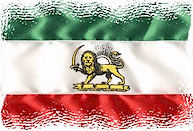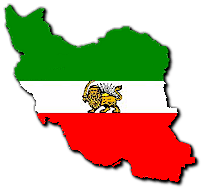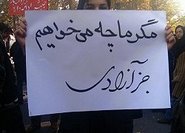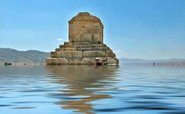U.S. defense officials have signaled that up-to-date attack plans are available if needed in the escalating crisis over Iran's nuclear aims, although no strike appears imminent. The Army and Marine Corps are under enormous strain from years of heavy ground fighting in Iraq and Afghanistan. Still, the United States has ample air and naval power to strike Iran if President Bush decided to target nuclear sites or to retaliate for alleged Iranian meddling in neighboring Iraq. Among the possible targets, in addition to nuclear installations like the centrifuge plant at Natanz: Iran's ballistic missile sites, Republican Guard bases, and naval warfare assets that Tehran could use in a retaliatory closure of the Straits of Hormuz, a vital artery for the flow of Gulf oil. The Navy has an aircraft carrier in the Persian Gulf area with about 60 fighters and other aircraft that likely would feature prominently in a bombing campaign. And a contingent of about 2,200 Marines are on a standard deployment to the Gulf region aboard ships led by the USS Kearsarge, an amphibious assault ship. Air Force fighters and bombers are available elsewhere in the Gulf area, including a variety of warplanes in Iraq and at a regional air operations center in Qatar. But there has been no new buildup of U.S. firepower in the region. In fact there has been some shrinkage in recent months. After adding a second aircraft carrier in the Gulf early this year - a move that Secretary of Defense Robert Gates said was designed to underscore U.S. long-term stakes in the region - the Navy has quietly returned to a one-carrier presence. Talk of a possible U.S. attack on Iran has surfaced frequently this year, prompted in some cases by hard-line statements by White House officials.

Vice President Dick Cheney, for example, stated on Oct. 21 that the United States would "not allow Iran to have a nuclear weapon," and that Iran would face "serious consequences" if it continued in that direction. Gates, on the other hand, has emphasized diplomacy. Bush suggested on Oct. 17 that Iran's continued pursuit of nuclear arms could lead to "World War III." Yet on Wednesday, in discussing Iran at a joint press conference with French President Nicolas Sarkozy, Bush made no reference to the military option. "The idea of Iran having a nuclear weapon is dangerous, and, therefore, now is the time for us to work together to diplomatically solve this problem," Bush said, adding that Sarkozy also wants a peaceful solution. Iran's conventional military forces are generally viewed as limited, not among the strongest in the Middle East. But a leading expert on the subject, Anthony Cordesman of the Center for Strategic and International Studies, says it would be a mistake to view the Islamic republic as a military weakling."Its strengths in overt conflict are more defensive than offensive, but Iran has already shown it has great capability to resist outside pressure and any form of invasion and done so under far more adverse and divisive conditions than exist in Iran today," Cordesman wrote earlier this year. Cordesman estimates that Iran's army has an active strength of around 350,000 men.At the moment, there are few indications of U.S. military leaders either advising offensive action against Iran or taking new steps to prepare for that possibility. Gates has repeatedly emphasized that while military action cannot be ruled out, the focus is on diplomacy and tougher economic sanctions. Asked in late October whether war planning had been ramped up or was simply undergoing routine updates, Gates replied, "I would characterize it as routine." His description of new U.S. sanctions announced on Oct. 25 suggested they are not a harbinger of war, but an alternative. A long-standing responsibility of the Joint Chiefs of Staff is to maintain and update what are called contingency plans for potential military action that a president might order against any conceivable foe. The secret plans, with a range of timelines and troop numbers, are based on a variety of potential scenarios - from an all-out invasion like the March 2003 march on Baghdad to less demanding missions. Another military option for Washington would be limited, clandestine action by U.S. special operations commandos, such as Delta Force soldiers, against a small number of key nuclear installations. The man whose responsibility it would be to design any conventional military action against Iran - and execute it if ordered by Bush - is Adm. William Fallon, the Central Command chief. He is playing down prospects of conflict, saying in a late September interview that there is too much talk of war.

"This constant drumbeat of conflict is what strikes me, which is not helpful and not useful," Fallon told Al-Jazeera television, adding that he does not expect a war against Iran. During a recent tour of the Gulf region, Fallon made a point of telling U.S. allies that Iran is not as strong as it portrays itself. "Not militarily, economically or politically," he said. Fallon's immediate predecessor, retired Army Gen. John Abizaid, raised eyebrows in September when he suggested that initiating a war against Iran would be a mistake. He urged vigorous efforts to stop Iran from acquiring nuclear weapons, but failing that, he said, "There are ways to live with a nuclear Iran." He also said he believed Iran's leaders could be dissuaded from using nuclear arms, once acquired. The possibility of U.S. military action raises many tough questions, beginning perhaps with the practical issue of whether the United States knows enough about Iran's network of nuclear sites - declared sites as well as possible clandestine ones - to sufficiently set back or destroy their program. Among other unknowns: Iran's capacity to retaliate by unleashing terrorist strikes against U.S. targets. Nonmilitary specialists who have studied Iran's nuclear program are doubtful of U.S. military action. "There is a nontrivial chance that there will be an attack, but it's not likely," said Jeffrey Lewis, director of a nuclear strategy project at the New America Foundation, a nonpartisan public policy group.
U.S. Fifth Fleet in Gulf exercise for possible war in Iran 2007/11/08 - From: Source

The U.S. Fifth Fleet has been operating two strike groups in the Gulf. The USS Enterprise and USS Kearsarge have also been training in the region.
(World Tribune)ABU DHABI — The U.S. Navy launched a series of exercises in the Gulf to enhance skills required in any war with Iran which, according to British press reports, could occur in early 2008.The U.S. Fifth Fleet conducted a crisis response exercise that included amphibious, air and medical forces. The five-day exercise by the USS Wasp, led by Commander Task Force 59, was scheduled to end on Nov. 5.The U.S. Fifth Fleet has been operating two strike groups in the Gulf. The USS Enterprise and USS Kearsarge have also been training in the region.Britain plans to send an aircraft carrier, HMS Illustrious, to the region in early 2008. Illustrious would be accompanied by the Type 42 destroyer HMS Edinburgh and the Type 23 frigate HMS Westminster.A British Defense Ministry spokesman said the Royal Navy deployment was not linked to the emerging Western crisis with Iran. But the London-based Daily Telegraph asserted that the ships might be preparing for war with Teheran in the first half of 2008."The purpose of the exercise is to continually improve the Fifth Fleet skills in completing complex missions that require capabilities broader than one ship or unit," U.S. Fifth Fleet commander Vice Adm. Kevin Cosgriff said. "Naval forces deployed here contribute to building stronger relationships that in turn help underwrite security and stability."Officials said the exercise would evaluate the capability of the USS Wasp to respond to oil spills or damage to a coalition ship in the Gulf. Under the scenario, the Wasp, an assault vessel, would rush personnel and supplies to a targeted area within 72 hours."The scenario is challenging but prepares us for a real-world event," CTF planning officer Cmdr. Jay Chambers said. "From the table-top discussions, which drew up plans for how our forces will assist, to turning those plans into action, this exercise allowed us to examine the best way to proceed, and to proceed quickly, with providing assistance to any requesting nation.

"The U.S. Navy also said it would deploy the Harry S. Truman Carrier Strike Group in the Middle East. The navy said the Truman would be accompanied by the guided missile destroyers Oscar Austin and Winston S. Churchill as well as the guided missile cruiser San Jacinto and the submarine Montpelier.Britain and Canada would also join the U.S. strike group, the navy said."Observers believe that the spring is the last possible moment for President George W Bush to order military strikes against Iran's nuclear programme," the Telegraph said. "The imminence of America's presidential election may make it impossible for Washington to carry out an attack any later."

























 اخبار مربوط به زندانیان سیاسی و نقض حقوق بشر
اخبار مربوط به زندانیان سیاسی و نقض حقوق بشر

















 Tulips in Holland
Tulips in Holland












No comments:
Post a Comment